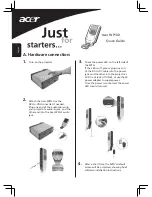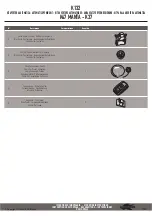
Operating Instructions
Manuel d’utilisation
Instrucciones de
funcionamiento
使用说明书
LIVE VIEW FINDER
VISEUR À VISION DIRECTE
VISOR LIVE VIEW
实时取景器
For Europe Only/Pour l
’
Europe seulement
C
Panasonic Corporation 2011
Panasonic Corporation
Web Site: http://panasonic.net
EU
Pursuant to at the directive 2004/108/EC,
article 9(2)
Panasonic Testing Centre
Panasonic Marketing Europe GmbH
Winsbergring 15, 22525 Hamburg,
Germany
VQT3T47
F1011SM0
Model No.
DMW-LVF2PP/
Model No.
DMW-LVF2E/
Model No.
DMW-LVF2GK
∫
Attaching the Live Viewfinder
A
This Live Viewfinder is designed only for the
Panasonic digital camera DMC-GX1.
(As of October 2011)
Preparation:
•
Turn off the camera.
•
Remove the Live Viewfinder connector
protective cover.
•
Remove the hot shoe cover that is attached to
the camera.
•
Place the hot shoe cover you have removed in
its storage bag and store in a safe location.
•
When attaching and detaching the Live
Viewfinder, be sure to do so slowly and
carefully.
∫
Slide the Live Viewfinder into the
hot shoe of the digital camera,
ensuring that it is fully inserted.
1
Hot shoe
2
Finder
3
[LVF/LCD] button
4
Dedicated connector for external
viewfinder
•
Press the lower part of the Live Viewfinder with
your finger, and securely insert the connector
as well. (Do not press on the viewfinder part or
the [LVF/LCD] button.)
∫
To remove the Live Viewfinder
B
1
Turn off the camera.
2
Return the angle of the Live
Viewfinder to its original position if it
has changed.
3
Pull in the direction of the arrow while
pressing the lock button.
•
Reattach the hot shoe cover in its original
position.
•
Using the Live Viewfinder with dirt on the
connectors may cause damage, so
attach the connector protective cover and
place it in the storage bag.
1
Lock button
∫
How to use
C
1
Switch [ON] the camera.
2
Press the Live Viewfinder [LVF/LCD]
button to switch the display.
•
Switching via the [LVF/LCD] button will be
maintained even when the power of the
digital camera is turned [OFF].
1
[LVF/LCD] button
∫
About the settings for recording
with a low camera angle
C
Based on the camera angle, set the angle
of the Live Viewfinder for easy viewing.
•
Do not open beyond 90
o
. Doing so may cause
damage.
∫
Diopter adjustment
D
Look at the display on the Viewfinder and
rotate the diopter adjustment dial to
where the screen is clearest.
1
Diopter adjustment dial
Note
•
Static electricity, electromagnetic waves or
other factors depending on the photographic
environment may cause the screen to turn
black temporarily; however this does not affect
the saved image.
•
If the finder is not displayed when using the
camera, it may be becoming loose. Re-attach
the finder.
•
The Live Viewfinder cannot be used with an
external flash.
•
Take care not to drop the Live Viewfinder or
subject it to strong impact.
•
Be particularly careful in the following places
as they may cause this unit to malfunction.
–
Places with a lot of sand or dust.
–
Places where water can come into contact
with this unit such as when using it on a rainy
day or on a beach.
•
Take care not to touch or dirty the finder
surface.
•
When the Live Viewfinder is fitted, do not use it
to hold the camera. The camera may drop out
of the Live Viewfinder and be damaged.
•
Before cleaning the Live Viewfinder, wipe
the Live Viewfinder with a dry soft cloth.
– When the Live Viewfinder is soiled badly, it
can be cleaned by wiping the dirt off with a
wrung wet cloth, and then with a dry cloth.
– Do not use solvents such as benzine,
thinner, alcohol, kitchen detergents, etc., to
clean the Live Viewfinder, since it may cause
the external case to deteriorate or the
coating to peel off.
– When using a chemical cloth, be sure to
follow the accompanying instructions.
•
As the eye cup cannot be removed, gently
wipe it with a dry and soft cloth, and be careful
not to remove it.
•
If you wipe the eye cup too hard and it is
removed, consult the dealer or your nearest
Service Centre.
•
Be sure to read the operating instructions of
your digital camera.
•
Condensation occurs when the ambient
temperature or humidity changes. Such
condensation could result in oxidation and or
corrosion of internal components leading to
service issues or the formation of mold in
extreme cases. Condition it to the ambient
temperature inside a bag etc. before use.
•
When not using the Live Viewfinder, be sure to
keep it in its storage bag. Store in a dry place,
taking care to avoid heat and humidity.
•
Do not spray the camera with insecticides or
volatile chemicals.
If the camera is sprayed with such chemicals,
the body of the camera may be damaged and
the surface finish may peel off.
•
Do not keep rubber or plastic products in
contact with the camera for a long period of
time.
•
Do not disassemble or modify this unit.
•
If nothing is displayed on the Live Viewfinder,
or if the display is not normal, it may be due to
the digital camera. Please have your digital
camera serviced together with this unit.
∫
Cautions for Use
Keep the unit as far away as possible
from electromagnetic equipment (such as
microwave ovens, TVs, video games,
radio transmitters, high-voltage lines
etc.).
•
Do not use the camera near cell phones
because doing so may result in noise
adversely affecting the pictures and sound.
•
If the camera is adversely affected by
electromagnetic equipment and stops
functioning properly, turn the camera off and
remove the battery and/or the connected AC
adaptor. Then reinsert the battery and/or
reconnect the AC adaptor and turn the camera
on.
∫
Specifications
Display:
Field sequential color
LCD viewfinder
(1,440,000 dots
equivalent)
Viewfinder Coverage:
Approx. 100%
Diopter value:
j
4 to
i
4diopter
Magnification
(35 mm film camera
equivalent):
Approx. 1.4
k
(Approx.
0.7
k
)
-1 m
-1
50 mm infinity
Eye Point:
Approx. 17.5 mm
(Approx.
0.689
q
) (-1 m
-1
)
Dimensions:
Approx. 29.4 mm (W)
k
47.7 mm (H)
k
48.9 mm (D)
[1.16
q
(W)
k
1.88
q
(H)
k
1.93
q
(D)]
Mass (Weight):
Approx. 36
g
(0.07937 lb)
Standard
Accessories:
Connector protective cover
Storage Bag
-If you see this symbol-
THE FOLLOWING APPLIES ONLY IN
CANADA.
THE FOLLOWING APPLIES ONLY IN THE
U.S.A.
N° de modèle
DMW-LVF2PP/
N° de modèle
DMW-LVF2E/
N° de modèle
DMW-LVF2GK
∫
Fixation du viseur à vision directe
A
Ce viseur à vision directe est conçu
uniquement pour l’appareil photo numérique
DMC-GX1 de Panasonic.
(En date d’octobre 2011)
Préparatifs:
•
Mettez l’appareil photo hors marche.
•
Retirez le couvercle protecteur du connecteur
du viseur à vision directe.
•
Retirez le couvercle de la griffe
porte-accessoires fixé à l’appareil.
•
Placez le couvercle de la griffe
porte-accessoires dans son sac de rangement
et rangez-le dans un endroit sûr.
•
Lorsque vous fixez ou désinstallez le viseur à
vision directe, veuillez procéder lentement et
avec soin.
∫
Glissez le viseur externe sur la
griffe porte-accessoires de
l’appareil en vous assurant qu’il
est complètement inséré.
1
Griffe porte-accessoires
2
Viseur
3
Touche écran ACL/viseur [LVF/LCD]
4
Connecteur dédié pour viseur externe.
•
Avec un doigt, appuyez sur la partie inférieure
du viseur; insérez également le connecteur à
fond. (N’appuyez pas sur le viseur ni sur la
touche écran ACL/viseur [LVF/LCD].)
∫
Retrait du viseur à vision directe
B
1
Mettez l’appareil photo hors marche.
2
Au besoin, remettez le viseur en sa
position initiale.
3
Tout en appuyant sur la touche de
verrouillage, tirez dans la direction de
la flèche.
•
Remettez le couvercle de la griffe
porte-accessoires en sa position initiale.
•
Utiliser le viseur à vision directe alors que
les connecteurs sont sales peut
l’endommager; aussi, est-il important de
mettre le couvercle protecteur du
connecteur en place et de ranger le tout
dans le sac de rangement.
1
Touche de verrouillage
∫
Utilisation
C
1
Mettez l’appareil photo en marche.
2
Appuyez sur la touche écran ACL/
viseur [LVF/LCD] pour commuter
l’affichage.
•
Le réglage effectué avec la touche [LVF/
LCD] est conservé même si l’appareil est
hors marche.
1
Touche écran ACL/viseur [LVF/LCD]
∫
Réglages pour des prises de vues
en contre-plongée
C
Selon l’inclinaison de l’appareil photo,
réglez l’angle du viseur de manière à
mieux voir.
•
Évitez de l’ouvrir à plus de 90
o
; cela pourrait
l’endommager.
∫
Ajustement dioptrique
D
Observez l’image affichée au viseur et
tournez la bague d’ajustement dioptrique
jusqu’à la position offrant l’image la plus
claire.
1
Bague de réglage dioptrique
Nota
•
De l’électricité statique, des ondes
électromagnétiques ou d’autres facteurs liés
aux conditions de prise de vue peuvent faire
virer l’écran au noir; toutefois, cela n’a aucun
effet sur l’image enregistrée.
•
Si aucune image n’est affichée au viseur
pendant l’utilisation de l’appareil, il se pourrait
qu’il y ait un problème de connexion.
Reconnectez le viseur.
•
Le viseur à vision directe ne peut être utilisé de
concert avec un flash externe.
•
N’échappez pas le viseur externe ni ne le
soumettez pas à de violents chocs.
•
Afin de prévenir les problèmes de
fonctionnement, faites particulièrement
attention dans les endroits suivants.
–
Endroits poussiéreux et où il y a du sable.
–
Endroits où l’appareil pourrait être mouillé
(pluie, éclaboussures, etc.).
•
Assurez-vous de ne pas toucher ou salir la
surface du viseur.
•
Lorsque le viseur est installé, ne l’utilisez pas
pour tenir l’appareil. L’appareil peut se
détacher du viseur et être endommagé.
•
Avant de nettoyer le viseur, essuyez-le
avec un chiffon doux et sec.
– Si le viseur externe devient très sale, il peut
être nettoyé à l’aide d’un chiffon doux
mouillé et essoré puis avec un chiffon sec.
– N’utilisez pas de solvants comme le
benzène, diluant, alcool, détergents de
cuisine, etc., pour nettoyer le viseur puisque
cela pourrait causer une détérioration de
son boîtier et son fini pourrait se décoller.
– Lorsque vous utilisez un tissu chimique,
assurez-vous de suivre les instructions qui
l’accompagnent.
•
Du fait que l’œilleton ne peut être enlevé,
essuyez-le délicatement avec un chiffon doux et
sec et prenez soin de ne pas tenter de l’enlever.
•
Si l’œilleton venait à se dégager,
communiquez avec le détaillant auprès de qui
vous avez acheté l’appareil ou avec un centre
de service à la clientèle.
•
Lisez attentivement le manuel d’utilisation de
votre appareil photo numérique.
•
De la condensation peut se former en cas de
changement brusque de la température
ambiante ou du taux d’humidité. La
condensation peut entraîner une oxydation ou
une corrosion des composants internes, d’où
un risque de problèmes de fonctionnement ou
la formation de moisissure dans des cas
exceptionnels. Avant d’utiliser l’appareil,
conditionnez-le aux conditions ambiantes en le
plaçant dans un sac de pastique, etc.
•
Après usage, remettez toujours le viseur à
vision directe dans son sac de rangement.
Gardez-le dans un endroit sec en prenant soin
d’éviter la chaleur et l’humidité.
•
Ne vaporisez pas l’appareil avec des
insecticides ou des substances chimiques
volatiles, cela pourrait causer une détérioration
de son boîtier et son fini pourrait se décoller.
•
Évitez de laisser des produits en caoutchouc
ou en plastique en contact avec l’appareil
pendant une longue période.
•
Ne démontez ni ne modifiez pas cet appareil.
•
S’il n’y a pas d’affichage sur le viseur à vision
directe ou si l’affichage semble anormal,
l’appareil photo numérique pourrait être en
cause. Faites vérifier le viseur et l’appareil
photo numérique par un technicien.
∫
Précautions à prendre
Évitez d’approcher l’appareil de tout
équipement magnétisé (four à
micro-ondes, téléviseur, équipement de
jeux vidéo, émetteur radio, ligne à haute
tension, etc.).
•
N’utilisez pas l’appareil photo à proximité d’un
téléphone cellulaire : cela pourrait entraîner un
bruit nuisible à l’image et au son.
•
Advenant le cas où le fonctionnement de
l’appareil serait dérangé par un champ
magnétique, coupez le contact, retirez la
batterie ou débranchez l’adaptateur secteur
pour ensuite soit remettre la batterie en place,
soit rebrancher l’adaptateur. Remettez
l’appareil en marche.
∫
Spécifications
Affichage :
Viseur couleur ACL à
séquence de trames
(équivalent de
1 440 000 points)
Couverture du
viseur :
Environ 100 %
Valeur dioptrique :
j
4 à
i
4
WARNING:
TO REDUCE THE RISK OF FIRE, ELECTRIC
SHOCK OR PRODUCT DAMAGE,
•
DO NOT EXPOSE THIS APPARATUS TO
RAIN, MOISTURE, DRIPPING OR
SPLASHING AND THAT NO OBJECTS
FILLED WITH LIQUIDS, SUCH AS VASES,
SHALL BE PLACED ON THE APPARATUS.
•
USE ONLY THE RECOMMENDED
ACCESSORIES.
•
DO NOT REMOVE THE COVER (OR BACK);
THERE ARE NO USER SERVICEABLE
PARTS INSIDE. REFER SERVICING TO
QUALIFIED SERVICE PERSONNEL.
Information on Disposal for Users of
Waste Electrical & Electronic Equipment
(private households)
This symbol on the
products and/or
accompanying
documents means that
used electrical and
electronic products
should not be mixed with
general household waste.
For proper treatment,
recovery and recycling,
please take these products to designated
collection points, where they will be accepted
on a free of charge basis. Alternatively, in
some countries you may be able to return
your products to your local retailer upon the
purchase of an equivalent new product.
Disposing of this product correctly will help
to save valuable resources and prevent
any potential negative effects on human
health and the environment which could
otherwise arise from inappropriate waste
handling. Please contact your local
authority for further details of your nearest
designated collection point.
Penalties may be applicable for incorrect
disposal of this waste, in accordance with
national legislation.
For business users in the European Union
If you wish to discard electrical and
electronic equipment, please contact your
dealer or supplier for further information.
Information on Disposal in other
Countries outside the European Union
This symbol is only valid in the European Union.
If you wish to discard this product, please
contact your local authorities or dealer and
ask for the correct method of disposal.
This Class B digital apparatus complies
with Canadian ICES-003.
FCC Note:
This equipment has been tested and
found to comply with the limits for a Class
B digital device, pursuant to Part 15 of the
FCC Rules.
These limits are designed to provide
reasonable protection against harmful
interference in a residential installation.
This equipment generates, uses and can
radiate radio frequency energy and, if not
installed and used in accordance with the
instructions, may cause harmful
interference to radio communications.
However, there is no guarantee that
interference will not occur in a particular
installation. If this equipment does cause
harmful interference to radio or television
reception, which can be determined by
turning the equipment off and on, the user
is encouraged to try to correct the
interference by one or more of the
following measures:
•
Reorient or relocate the receiving antenna.
•
Increase the separation between the
equipment and receiver.
•
Connect the equipment into an outlet on a
circuit different from that to which the
receiver is connected.
•
Consult the dealer or an experienced radio/
TV technician for help.
Any unauthorized changes or
modifications to this equipment would void
the user’s authority to operate this device.
This device complies with Part 15 of the
FCC Rules. Operation is subject to the
following two conditions: (1) This device
may not cause harmful interference, and
(2) this device must accept any
interference received, including
interference that may cause undesired
operation.
Responsible Party:
Panasonic Corporation of North America
One Panasonic Way
Secaucus, NJ 07094
Support Contact:
Panasonic Consumer Electronics
Company
Telephone No.: 1-800-211-PANA (7262)
ENGLISH
FRANÇAIS
コピー ~ DMW-LVF2_PP_GK.fm 1 ページ 2011年10月3日 月曜日 午後4時48分




















